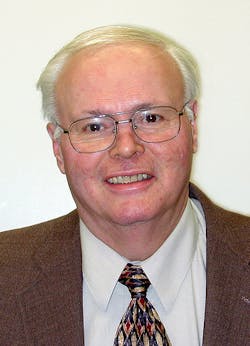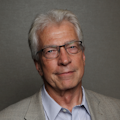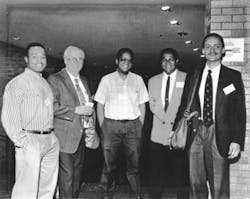Business Forum: Diversity in photonics strengthens society

Dr. Robert Alfano is Distinguished Professor of Science and Engineering in the Departments of Physics and Electrical Engineering, and he is the Director and Founder of the Institute for Ultrafast Spectroscopy and Lasers (IUSL) at The City College of New York (CCNY). He is well known for his discovery of the supercontinuum, for his work with ultrafast lasers, and for developing new biomedical technologies and applications. He is less well known for his important role in advancing women and minorities in science and technology.
I talked to him about this aspect of his life and about the fact that neither the academic nor commercial sides of the photonics community reflect the general U.S. population. It’s no secret that both women and minorities are significantly underrepresented. Are things changing, and how will the community and society benefit?
Conard Holton: What brought you to CCNY?
Robert Alfano: CCNY was founded in 1847 with the mission of offering an affordable education (once free, now $6330/year), and to recruit and support a diverse student population, reflective of both New York City and the global society.
I was drawn to CCNY by its mission to educate “disadvantaged” students. I like the challenge of being an underdog and competing with the best. My main objective was to pay back the people who helped me in my journey to become a scientist. Sometimes, I feel like Robin Hood—helping students in Harlem to attain higher levels of research and education. Education is power, and power enables a better life.
CH: How did you get started in your career?
RA: I did not come from elite schools or work for a premiere research company. I was lucky to work for a small R&D company, GTE Labs in Bayside, Queens, first as a technician and rising through the ranks to become a member of the technical staff—a great research job. GTE (now Verizon) was the underdog in comparison to Bell Telephone. My job was to keep GTE abreast of advances in science.
A laser group was formed and I was transferred into it under Alex Lempicki—more good luck. To select modelocked lasers to investigate and generate picosecond lasers was, again, a break, as well as to have and use the knowledge of solid-state physics that was being taught by Prof. Joe Birman (my PhD advisor at NYU) and Dr. Nate Ockman, who explained underlying optical physics of solids. I also thank Esther Conwell, who hired me at GTE and with whom I worked during my early years there.
I also made many major discoveries with Dr. Stan Shapiro, and with him I learned that we could compete with the best. I made the discovery of supercontinuum and made the first optical phonon lifetime in crystal with Stan. We captured attention in the ultrafast laser field using picosecond laser pulses to unravel basic processes worldwide.
When GTE moved from Bayside to Boston, my friend Larry Jacobowitz recommended that I apply to CCNY. Mel Lax, a famous theorist, was spearheading the development of CCNY’s physics research under Harry Lustig and an National Science Foundation (NSF) grant. I was lucky (again) to help make CCNY the “Harvard of the poor” to do research: Under Provost Lustig, I formed the Institute for Ultrafast Spectroscopy and Lasers (IUSL) to enable state-of-the-art ultrafast laser research. Hamamatsu presidents Ralph Eno (U.S.) and Teuro Hiruma (Japan) supported my Photonic Application Laboratory at IUSL for five years with funding and state-of-the-art photodetection equipment (including six streak cameras). The Department of Defense (DoD)—in particular, the Army Research Office (ARO), Air Force Research Laboratory (AFRL), the Air Force Office of Scientific Research (AFOSR), and the NSF—provided many grants in the ‘70s and ‘80s to support our research.
I had no formal training in high school and little desire to pursue physics. I came from a tough junior high school in East Harlem, where my math teacher, Mr. Resnick, championed my math skills. At Teaneck High School, Mr. Lowell took me under his wing and gave me extra advanced math topics. I went to Fairleigh Dickinson University because it was close my house. There, I was lucky to learn from Jack Felman (on leave from Princeton Advanced Studies) all levels of physics, and I obtained a Physics MS in one year.
CH: What has that meant for you personally and as a teacher?
RA: Being a teacher is great. I teach advanced undergraduates in physics and electrical engineering on the state-of-the-art in optical physics. I bring to students my research understanding to help them understand the real world. In my early days at CCNY, some senior professors said that some of my courses were too advanced—but I felt confident that I could explain the concepts sufficiently. Like Jack Felman, I still push my students to understand at the highest levels. Doing so has allowed me to expose students to topics like condensed matter, photosynthesis, vision, and biomedical research in using state-of-the-art ultrafast laser hardware and detection systems that they would not have a chance to learn otherwise.
It was not easy to train students who often lacked confidence to compete with top universities. Before long, though, smart and eager students such as Peter Delfyett, Anthony Johnson, Stavros Demos, Giovanni Milione, X. Ni, K. M. Yoo, and many others were competing at the highest levels with passion and hard work.
CH:Do you now see photonics education expanding to include more minorities?
RA: There are positions available for all, but at CCNY Physics Graduate School there is no special effort to secure minorities.
CH: Women and minorities seem to have made some progress in the academic world—how can you help more of your graduates enter and succeed in the business world?
RA: Thus far, 54 PhDs have graduated from my lab: 8 are women and 6 are men of racial minority. Some of the African-American graduates of my lab have gone on to hold distinguished positions in academia and business, notably Anthony Johnson (professor of physics and director of CASPR at UMBC), Peter Delfyett (director of the Ultrafast Photonics Group at CREOL), Ardie Walser (Associate Dean of Undergraduate Affairs at the Grove School of Engineering at CCNY), and Jean Dolne (Technical Fellow at Boeing).My women students have passion for science, and work extraordinarily hard with enthusiasm—which I call “the big E.” Women PhD graduates who have made marks in academia include Asima Pradham, professor of physics at the Indian Institute of Technology in Kampur, India. Dana Calistru, now director at Barclays Capital, is an example of how women scientists can achieve at high levels in business. An example of a current student is Sabina Grech, who has worked in my lab on laser tissue welding and was just accepted to medical school.
CH: Are your students looking at careers in business or academia—or both? What do you say to your students as they contemplate their future?
RA: Most are looking for careers in academia. I tell them: As long as you work hard and have strong passion for what you want to do, your education will improve your life. No one can take away your PhD, and even if you don’t land exactly where you aim for, you can be very accomplished and make important contributions.
CH: You have been involved in many diverse research activities, and biomedical optics has been of particular interest. What specific research area is most interesting to you right now?
RA: Currently, my strongest interests are in four projects: 1) Detecting aggressive cancer using the colors of light, called optical biopsy; 2) Solar energy conversion using most of the solar spectrum to convert photons to electrons and provide current to produce electricity; 3) Using a complex waveform in optical angular momentum to look at hidden states; and 4) Neuroscience and memory research using optics and quantum effects to give a more fundamental picture of what goes on in the brain.
I was inspired to pursue the latter when I met Lingyan Shi, then a research associate using a two-photon microscope with femtosecond lasers. After earning a PhD in biomedical engineering with Prof. Bingmei Fu at CCNY, she began a research associate fellowship working with both myself and Prof. Adrian Rodriguez-Contreras of CCNY’s Department of Biology. Now, we have a strong interdisciplinary group involving biology, neuroscience, optical physics, and ultrafast lasers. I am excited about the pioneering work we are doing in optical imaging of the animal brain and resonance Raman research for Alzheimer’s disease.
About the Author

Conard Holton
Conard Holton has 25 years of science and technology editing and writing experience. He was formerly a staff member and consultant for government agencies such as the New York State Energy Research and Development Authority and the International Atomic Energy Agency, and engineering companies such as Bechtel. He joined Laser Focus World in 1997 as senior editor, becoming editor in chief of WDM Solutions, which he founded in 1999. In 2003 he joined Vision Systems Design as editor in chief, while continuing as contributing editor at Laser Focus World. Conard became editor in chief of Laser Focus World in August 2011, a role in which he served through August 2018. He then served as Editor at Large for Laser Focus World and Co-Chair of the Lasers & Photonics Marketplace Seminar from August 2018 through January 2022. He received his B.A. from the University of Pennsylvania, with additional studies at the Colorado School of Mines and Medill School of Journalism at Northwestern University.
